Scene 01 02 03 04 05 06 07 08 09 10
Chinatsu suspects Makoto
dialog
parsed 日本語
おにいちゃん…
ふとん もってった、ああ?
うん
ねえ、おにいちゃん
うん?
literal
big brother…
futon hand-carried, yes?
mm-hmm
eeh… big brother…
yes?
English
Kei…
Did you bring her the futon?
mm-hmm
eeh… Kei…
yes?
「あの 人」って いつまで うちに いるの
くわしい ことは きいて ない けど…
一人まえに なるまで かな
一人まえ?
‘that person’ when-until home-at will-exist ?
detailed thing? heard-not but…
full-fledged become-until, I-wonder
full-fledged?
until when is she going to stay here?
I haven’t heard the details but…
I think until she is qualified
qualified?
なんだよ いやなのか
そう じゃ ない けど
あの 人、「あぶない 人 だな」って おもった
ああ?
だって、だって
あの 人、先 ねことね、はなして たんだ…
why ?! disagreeable one?
so isn’t but…
that person “danger person is, right?” thought
ah?
because… because…
that person, before cat-with, well… talking was…
why? You don’t like her?
that’s not it, but…
I think she is dangerous
ah?
’cause… ’cause…
well… a while ago she was talking to her cat…
ああ、いい におい
おひるは カレー ですか
そう、きのうののこりもの だけどな
カレーは 一日 おいた ほうが おいしい です もんね
ah! good smell
lunch? curry is?
yes, yesterday’s remain-thing is but, right?
curry? one-day aged side! tasty-is because, right?
ah! it smells good
is lunch curry?
yeah, but it’s just yesterday’s leftovers
it’s because a day-old curry is delicious
あれ…? チトは?
ああ、「ダイエット 中 だから、おひる いらない」って
hmm…? Chito?
ah… “diet middle is because, lunch unnecessary”
hmm? and Chito?
ah… she says she’s in the middle a diet so she’s not having lunch
どうか しましたか、千なつちゃん?
なんだ あいつ?
how? happened? Chinatsu?
what’s-the-deal that-person?
something wrong, Chinatsu?
what’s up with her?
vocabulary
To listen to a word in Japanese, highlight it and press the speaker icon.
おにいさん
ふとん
いつ
くわしい
一人まえ
なる
いや(な)
あぶない
だって
先
ねこ
はなす
におい
おひる
カレー
きのう
のこり
もの
のこりもの
一日
おい
ほう
おいしい
もん
ダイエット
ちゅう
いらない
あいつ
big brother
japanese futon, i.e., a thin matress
when
detailed
qualified (いちにんまえ)
to become
disagreeable
dangerous
because
before, ahead
cat
to speak
smell, fragrance, scent
lunch (lit. respectable noon)
curry
yesterday
remnant, residue
tangible thing
leftover (lit. residue thing)
one-day, all-day
old, age
direction; way; side
delicious, tasty
explanation, reason
diet
middle (on-yomi of 中)
not necesary, not needed, not wanted
that person over there
new expressions
P&T notes – casual vs. formal
We tend to use casual speech when we are with family and friends, and formal speech when we are with superiors and strangers. However, there is nothing to prevent a person from being naturally polite, even within family, or naturally casual, even in situations that merit some formality. In this anime/manga, Makoto is a polite girl and uses formal speech all the time, while Kei, Nao and Chinatsu tend to use casual speech. Casual and polite speech differ in many respects, some of which we describe below.
word origin
In a language, words originally from that language tend to be casual while words borrowed later into the language tend to be formal. For example, in English, words from Old English, e.g., “to buy”, are casual, while words borrowed later from French, latin or greek have a formal or academic flair to them, e.g., “to procure”, “to acquire”, “to purchase”. In Japanese, casual words tend to be originally Japanese, which means that kun-yomis tend to sound casual, while words with a Chinese origin tend to sound formal, which means that on-yomis tend to sound formal.
Let’s see an example. 今日 means ‘today’; its ortographic borrowing, which is like a kun-yomi, is きょう, which is the Japanese word for today; it is used in everday life. We can also pronounce 今日 using on-yomis, as こんにち, of Chinese origin, which also means “today”, in the sense of “the present time”; こんにち sounds more formal than きょう, and it is the basis of the the こんにちは greeting. Finally, we can also say “today” using the on-yomi of 本日, i.e., ほんじつ; this is used in the news, in rituals and ceremonies, and in documents, so it is much more formal than きょう.
Another example is 明日, which means “tomorrow”: the ortographic-borrowed kun-yomi あした is the casual original Japanese word, for everyday use; あす is more formal, used in the news; and the on-yomi みょうにち is the more formal Chinese-based on-yomi word, used in rituals and documents.
personal honorifics
A personal honorific indicates the level of respect toward another person, similar to the English “Mr.” of “Mrs”. In English we have only a few, while in Japanese there are many more so, by force, we cannot translate them correctly. Worse, since Japanese is such a power-distance aware culture, they use these honorifics all the time and pretty much with everyone around them, e.g., family, friends, students, teachers, bosses, etc. Some examples are さん, ちゃん, くん, どの, さま, せんぱい, ちゃま, せんせい, ちょう, etc.

We sometimes add the さん honorific to people that work at a store, e.g., パンやさん, where パン is “bread”, パンや is “bakery”, and パンやさん is “baker”. Although the main use of さん is to show respect to people, it is sometimes used to show respect to objects. In the panel on the right, the polite Makoto refers to the hardware store as ざっかやさん, while the casual Kei refers to it as ざっかや.
In the anime, Makako always addresses Kei and Chinatsu as けいくん (young Kei) and 千なつちゃん (dear Chinatsu). Kei, being a naturally casual person, addresses both Nao and Makoto by their names, without honorifics, and being the older brother, also addresses Chinatsu by her name. Chinatsu, being at the bottom of the power totem-pole, addresses Kei as おにいちゃん (dear-big-brother Kei) and Makoto as まこねえ, which is her abrreviation of まことおねえちゃん (dear-big-sister Makoto).
word honorifics
The prefix お rises the level of respect of a Japanese-origin word. For example, the word for ‘older brother’ is the Japanese-origin にい; to address an older brother, we would often add a personal honorific like さん or ちゃん, to end up with にいさん or にいちゃん; to raise the respect even more we add the prefix お to end up with おにいさん or おにいちゃん. In the anime, 千なつ addresses her big brother けい as おにいちゃん. Likewise, to be respectful, we can say おかね instead of かな (money), おさけ instead of さけ (sake), お水 instead of 水 (water), etc.
To rise the level of respect of a Chinese-origin word, we use ご. For example, our own family is かぞく and our own husband is しゅじん, both of Chinese origin. To show respect, someone else’s family and husband are ごかぞく and ごしゅじん.
As always, there are exceptions. For example, the words for “tea” and “stroll” are ちゃ and さんぽ, of Chinese origin, but their honorific prefix is お, as if they were Japanese words: おちゃ and おさんぽ; this lowers the foreign aura of the Chinese-origin word and makes the word more casual. Also, normally we will not give neither of these honorifics to words that we would write in katakana, like ピアノ (piano) or ビール (beer), but a few can take honorifics, like the Portuguese-borrowed おタバコ (tobacco).
particle dropping
Formal speech tends to be explicit and have a lot of particles, while casual speech tends to be implicit and leave particles out. The type of particles that it tends ot leave out is specific, though. Emotional particles tend to be present in both formal and casual speech, but they tend to acquire the tone of the respective form, i.e., ね vs. な, か vs. の, では vs. じゃあ, etc. Sometimes, in casual speech, we drop particles that work as markers of parts of the sentence, like が, は and を, or that play the role of English prepositions, like に, で, or へ.
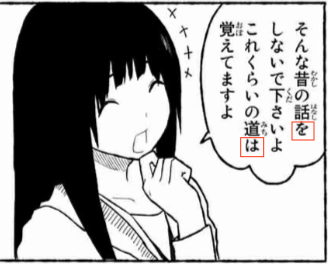
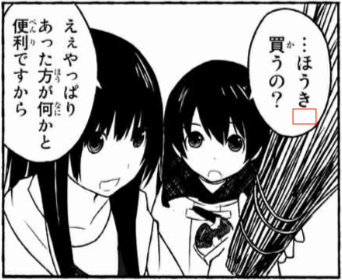
verb forms
The casual form of a verb is called the dictionary form because it’s the form in which we would find the verb in a dictionary; the formal form of the verb is the ます form. The copula also has a casual form, だ, and a formal form, です.
The English translation of both forms casual and formal forms is identical so the formality nuance is lost in translation. For example:
formal
です
します
きます
casual
だ
する
くる
formal
あります
います
かいます
なにを かいますか?
casual
ある
いる
かう
なに かうの?
i-adjective endings
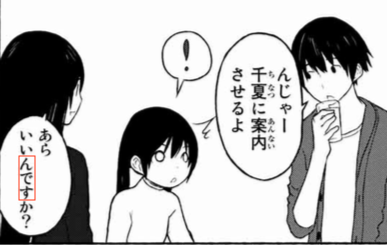
i-adjectives can work as verbs too, but to make them polite, instead of changing their inflections, we append a suffix. For example, ほしい is “wanted-is” (or “I want it”), which sounds demanding; to make it more of a request we add an ん, e.g., ほしいん. Since ほしい already has an implicit verb, it does not need to close with です, but we can add it as a decoration that increases the politeness of the sentence, e.g., ほしんです (or “I’d like it”). We can make it even more polite but saying “I’d like it, if it is not a problem”, appending が, けど, けれど or けれども. As usual, the longer the result, the more formal the sentence. In the manga, Makoto frequently uses -んです.
particle usage
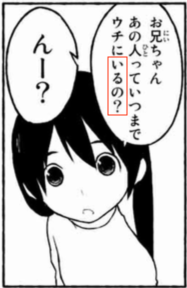
Particles also indicate the level of formality. For example, the formal agreement-seeker particle is ね, while the casual version is な. Discourse markers also have the two forms, e.g., the formal form of “well…” is では while the casual one is じゃあ. Likewise, the formal version of the spoken question mark is か while the casual version is の.
We should keep these particles in agreement with the form of the sentence. For example, わかりますか? is a formal way to ask “do you understand?”, while わかるの? is a casual one, but わかるか? sounds insulting, e.g., it is a form that we are more likely to hear in a confontation between two gangs than in a conversation between two people. In the panel on the right, Chinatsu is asking with いるの?, matching the casual verb いる with the casual spoken question mark の.
a gamut of speech
Saying that Japanese has ‘a’ casual speech form and ‘a’ formal speech form is an oversimplification because there are a variety of ways in which we can raise or lower the politeness of a sentence; we can use many of these ways to raise the level of politeness a lot, or use only a few and raise the level of politeness only a bit. For example, all the following clauses mean the same, with various levels of politness:
politeness level
formal
formal-
casual++
casual+
casual
I’m not going back
かえりません
かえらないんです
かえらないです
かえらないん
かえらない
In this page, we described the expression “どうか しましたか?” that Makoto uses to ask Chinatsu “what happened?”. If we listen to the audio, indeed, this is the expression that Makoto always uses. However, in the manga, Makoto sometimes uses “どうしましたか?” and sometimes uses “どうか したんですか?”:
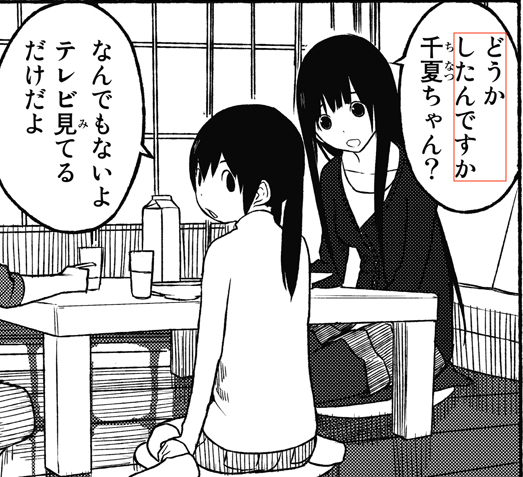

One of the reasons we bring this up is to show how Makoto uses both “casual”+んです and the formal ます form to be polite; although there might a grammatical reason to argue about which of the two forms is actually more polite, a Japanese would have troubles deciding it; both forms are very polite. Part of the problem of deciding is that しました is the formal ます form, but it is shorter than the casual-turned-formal したんです form and, as we described before, longer speech forms are inherently more formal than shorter ones.
The second reason to bring up the difference between the manga and the anime is because it presents us with a great anecdotical opportunity. The manga was writen by a Japanese and the translation to the anime was done by a Japanese. Hence, if we find a discrepancy between the dialog in the manga and the anime, we have to assume that in their view, the dialogs of both manga and anime are correct and equivalent from the point of view of native speakers of Japanese. In this example, the discrepancy between しました and したんです tell us that both forms are basically undistinguishable for the purpose of satisfying the situation in which the dialog takes place. Here, the discrepancy gives us an anectodical case to exemplify the gamut of politeness forms.